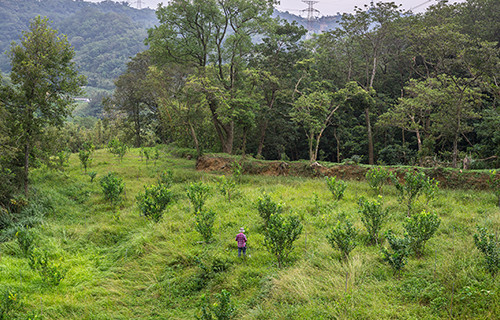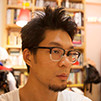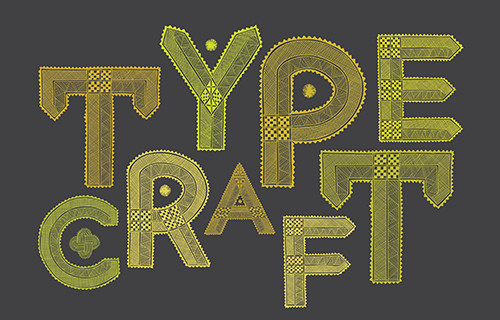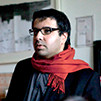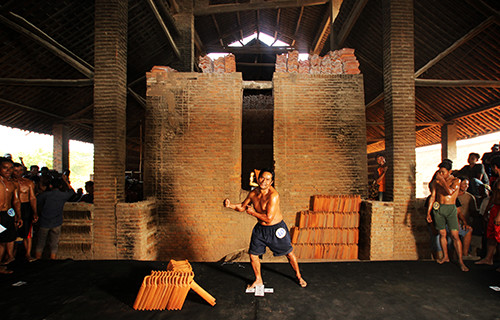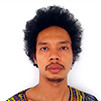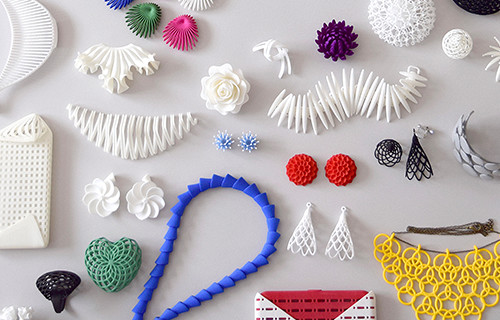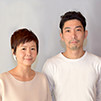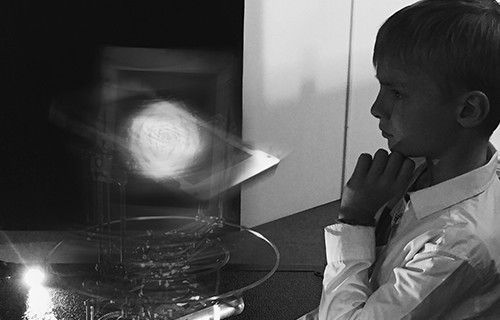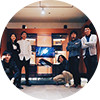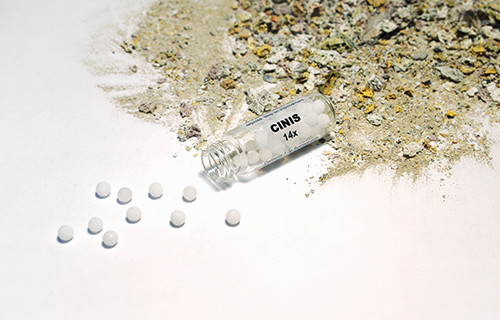
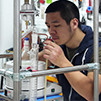
ペク・ジョンギ Beak Jungki
Beak Jungki ペク・ジョンギ
https://jungkibeak.blogspot.jp/1981年生まれ、ソウル在住。信仰や東洋哲学、科学などを横断しながら、自然や社会の治癒、あるいは生態系の循環などを作品化してきた。本展では2003年の大邱地下鉄放火事件をめぐる新作を発表する。
Beak Jungki (b. 1981) currently lives in Seoul. He has channeled his interests in religion, Eastern philosophy, and natural science in a series of works focusing on ecological cycles and healing both of nature and society. The artist exhibits the work relating to the Daegu subway fire in 2003.
マテリア・メディカ(薬物学)—冷たい灰
Materia Medica: Cinis
写真、映像、新聞紙、本、灰、ラクトース(乳糖)、小瓶ほか
2017年
photograph, video, newspaper, book, ashes, lactose (sugar of milk), vial and others
2017
2003年2月18日、韓国大邱(テグ)市の地下鉄でこれまでにない規模の放火事件が発生した。 この火災により192人が亡くなり、21人が行方不明、151人が負傷をおった。10カ月後、地下鉄構内は一新され、事件前の日常に戻ったかのように思われたが、その場を訪れた作者にはただ違和感が残ったという。 本作では、この地下鉄火災で受けたようなトラウマを癒すために、ホメオパシー(同種療法)の理論を取り込み、「冷めたい灰」という薬が作られた。 それは事件現場から採取されたわずかな灰を、水で極限にまで薄めたものだという。 本展の開幕日が事件のあった2月18日だというのは、まったくの偶然なのだろうか。
The largest arson attack occurred in the Daegu subway in the Republic of Korea in 18 February, 2003. The fire killed 192 and injured 151 people, with 21 still missing. The subway station was restored ten months later. All seemed to have returned to normal yet the site still imparts discomfort and a sense of unease for the artist. In this work, Beak Jungki created a homeopathic remedy called “Cinis” to heal traumatic memory caused by tragedies like the arson attack. A small amount of ash was collected from the site and diluted with water. Is it mere coincidence that this exhibition opens 18 February, the very same day as the arson attack of 2003?
《マテリア・メディカ》を制作するにあたって、必要不可欠な「技術」と「知識」は何ですか。
For making the Materia Medica, what is a vital skill/technology and knowledge?
Beak Jungki: この作品は、ホメオパシー(同種療法)についての進行中の研究に基づいています。 ホメオパシーは「似たものが似たものを治す」という考え方に基づく薬物学の一種です。 これは東洋医学における「毒をもって毒を制す」という考え方にも通じます。 ホメオパシーは、特定の病気や症状を起こす物質によって、その病気を治すことができると主張します。 病気の症状は治癒の過程として捉えることができ、ゆえにその症状の原因となっている成分によって、治癒を促進できるのです。 成分を取り込む際は、蒸留水かアルコールで希釈する必要があります。 希釈することで、成分による副作用を抑え、レメディ(治療薬)としての効能を最大化するのです。 レメディはしばしば口から摂取しやすいように、砂糖でできた丸薬として提供されます。 今回、作品づくりの過程において、どうすれば本当の意味で傷を癒すことができるのか、という問いへの答えを探るなかで、ホメオパシーにたどり着きました。 傷は個人的なものですが、私たちが生きるコミュニティーの中で混乱や対立を生み出す社会的な傷もあります。 社会的な傷の場合、問題の核心を見ずに希望について語ることが、通常治癒として捉えられています。 しかし、真の治癒のためには、痛みや対立を治癒の不可欠なプロセスと積極的に捉えることが必要だと考えます。 ホメオパシーのように。
Beak Jungki: The work, Materia Medica: Cinis, is based on my ongoing research about Homeopathy. Homeopathy is the system of medicine which works on the principle of ‘like cures like.’ This concept of principle is similar to the doctrine, 'poison kills poison' from Eastern medicine. Homeopaths claim that a disease can be cured by a substance that produces similar symptoms with those of the disease. Because the symptoms are perceived as parts of healing process and the substance causing the same symptoms could accelerate the healing process. Before taking a dose of substance, it must be diluted with distilled water or alcohol since the diluting process reduces the side-effect and maximizes the efficiency of substance as a remedy. The remedies are often formulated as pellets made out of sugar to be placed under the tongue for convenient dose. The reason why I adapt Homeopathy as a reference in my project is because I was seeking for the answer to the question of what the true healing of wound is. The wound would be something individual but also social causing confusion and conflict in our community. Especially in the case of social wounds, blanketing the dark side and only talking about hope are normally regarded as a healing. However, I believe that the true healing includes the encouragement of accepting the pain and conflict as a necessary process, as in Homeopathy.
この作品を制作するにあたって、必要不可欠な「サイクル」は何ですか。
For making the work, what is a vital cycle?
Beak Jungki: 東洋哲学には、万物の構造と変化を説明する「五行説」という考え方があります。 この説の根底には、万物は常に循環しているという考え方があります。 この循環という考え方は、段階的なプロセスの必要性を感じさせます。 西洋のことわざに「4月の雨が5月の花を連れてくる」というものがあります。 このことわざが意味するのは、十分な痛みがあってはじめて果実が得られるというものです。 これもまた、ホメオパシーにおける治癒の考え方につながっています。
Beak Jungki: In Eastern philosophy, there is the doctrine called “Five Element of Universe,” describing the structure and movement of the universe. The most fundamental idea of this doctrine is that the universe is constantly circulating. The meaning of this cycle implies the necessity of process. There is a western proverb, ”April Showers bring May flowers.” This proverb means that only enough pain brings fruits. It is also associated with the principle of homeopathy emphasizing the process.
あなたにとっての「アート」とは何ですか?
What is art for you?
Beak Jungki: 現代美術においては、何でもアート作品になりえますが、すべてのアートが良いものであるとは限りません 良いアートとは、哲学や科学のように、万物の本質についての研究に近いと思います つまり絶対的で普遍的なもの、そして私たちを真理に導いてくれるものでなくてはなりません ただしアーティストの場合は、作品制作の道具として嘘を用いることが可能であり、そのことが他の分野とは決定的に異なる点だと思います。
Beak Jungki: In contemporary art scene, everything can be an art work but it does not mean that every art is good. I believe that the good art is more like study of the essence of the universe such as philosophy and science. Therefore the good art should be absolute and universal, driving us to the truth although the most of artists use lies as tools and this is the biggest difference from other disciplines.
この作品をどのように展開させたいですか?
How do you want to develop the work?
Beak Jungki: ホメオパシーの考え方を支えるもう一つの理論に「水の記憶」があります。 ホメオパシーのレメディ(治療薬)をつくる過程で、成分は蒸留水で希釈され、その分子は無くなります。 しかしこの水は成分のエネルギーあるいは情報を含んでいるため、レメディとして機能しうるのです。 1988年、フランスの免疫学者ジャック・バンヴェニストは、ウィルスのような細菌を水で極度に希釈し、その水を直接人間の身体に注入しました。 その結果、体内の白血球が活性化したことが確認されたのです。 水には病原体の分子は全く残っていないにも関わらず。 この実験が示すのは、物質には物理的な側面以外に、情報や記憶といった形のない要素も含まれているということです。 また、ジェーン・ベネットは著書『振動する物質』において、すべての物資には固有の活力があると言いますが、それを私は記憶、エネルギー、あるいは気と捉えています。 私は作品のなかで自分自身を二元的な存在として捉えています。 東洋と西洋、精神と身体、あるいは原始宗教と科学といった、相反するもの同士を相互に補完し、つなぎ合わせる存在として。 私の作品が、統合的な知に基づき、分断されたイデオロギーを治癒し、また万物の研究につながればと思います。
Beak Jungki: I did not mention above but there is another fundamental theory supporting Homeopathy called “Water Memory.” In the preparation of homeopathic remedy, the substance is so diluted with distilled water that no molecule of the substances remain. However, the water still can works as a remedy because it stores the energy or information of the substances. In 1988, Jacques Benveniste, a French immunologist extremely diluted certain germs such as virus with water and injected the water into human body. Presently, he discovered that the leukocyte response in the body becomes active although there is no single molecular of pathogens left in the water. This experiment tells us that the element that constitutes a substance includes not only its material, but also its information and memory. This theory is also associated with New Materialism supported by the book, Vibrant Matter, written by Jane Bennett. She claims that every matter has its inherent vitality, which I would refer to the memory, energy or Chi(氣). In my work, I have been positioned myself between something dualistic such as Eastern and Western, Mental and Body, and Shamanism and Science, in order to make them connected complementary. My work aims to be a healing process of divided ideology as well as a study of the universe based on the integrated and unitary knowledge.


